NCERT Solutions for Chapter 10 Circles Class 9 Maths
Book Solutions1
(i) The centre of a circle lies in _________ of the circle.
(ii) A point, whose distance from the centre of a circle is greater than its radius lies in _________ of the circle.
(iii) The longest chord of a circle is a _________ of the circle.
(iv) An arc is a _________ when its ends are the ends of a diameter.
(v) Segment of a circle is the region between an arc and _________ of the circle.
(vi) A circle divides the plane, on which it lies, in _________ parts.
Answer
(i) interior(ii) exterior
(iii) diameter
(iv) semicircle
(v) the chord
(vi) three
2
(i) Line segment joining the centre to any point on the circle is a radius of the circle.
(ii) A circle has only finite number of equal chords.
(iii) If a circle is divided into three equal arcs, each is a major arc.
(iv) A chord of a circle, which is twice as long as its radius, is a diameter of the circle.(v) Sector is the region between the chord and its corresponding arc.
(vi) A circle is a plane figure.
Answer
(i) True [∵ All points on the circle are equidistant from the centre](ii) False [∵ A circle can have an infinite number of equal chords.]
(iii) False [∵ Each part will be less than a semicircle.]
(iv) True [∵ Diameter = 2 × Radius]
(v) False [∵ The region between the chord and its corresponding arc is a segment.]
(vi) True [∵ A circle is drawn on a plane.]
1
Answer
We have a circle having its centre at O and two equal chords AB and CD such that they subtend ∠AOB and ∠COD respectively at the centre, i.e. at O.We have to prove that ∠AOB = ∠COD
Now, in ΔAOB and ΔCOD, we have
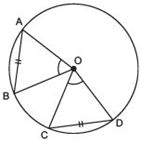
AO = CO [Radii of the same circle]
BO = DO [Radii of the same circle]
AB = CD [Given]
∴ ΔAOB ≌ ΔCOD [SSS criterion]
⇒ Their corresponding parts are equal.
∴ ∠AOB = ∠COD
2
Answer
We have a circle having its centre at O, and its two chords AB and CD such that∠AOB = ∠COD
We have to prove that AB = CD
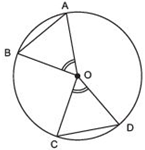
∵ In ΔAOB and ΔCOD, we have:
AO = CO [Radii of the same circle]
BO = DO [Radii of the same circle]
∠AOB = ∠COD [Given]
∴ ΔAOB ≌ ΔCOD [SAS criterion]
∴ Their corresponding parts are equal, i.e. AB = CD
1
Answer
Let us draw different pairs of circles as shown below:
We have
| In figure | Maximum number of common points |
| (i) | nil |
| (ii) | one |
| (iii) | two |
Thus, two circles can have at the most two points in common.
2
Answer
Steps of construction
I . Take any three points on the given circle. Let these be A, B and C.
II. Join AB and BC.
III . Draw the perpendicular bisector PQ of AB.
IV. Draw the perpendicular bisector RS of BC such that it intersects PQ at O.
Thus, ‘O’ is the required centre of the given circle.
3
Answer
We have two circles with centres O and O', intersect at A and B.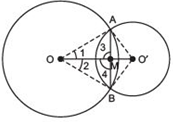
∵ AB is the common chord of two circles and OO' is the line segment joining the centres of the circles. Let OO' and AB intersect each other at M.
∴ To prove that OO' is the perpendicular bisector AB, we join OA, OB, O'A and O'B.
Now, in ΔOAO' and ΔOBO',
we have, OA = OB [Radii of the same circle]
O'A= O'B [Radii of the same circle]
OO' = OO' [Common]
∴ Using the SSS criterion,
ΔOAO'≌ ΔOBO'
⇒ ∠1= ∠2 [c.p.c.t.]
Now, in ΔAOM and ΔBOM,
OA = OB [Radii of the same circle]
OM = OM [Common]
∠1= ∠2 [Proved]
∴ ΔOAM ≌ ΔBOM [SAS criterion]
⇒ ∠3= ∠4 [c.p.c.t.]
But ∠3 + ∠4 = 180º [Linear pair]
∴ ∠3= ∠4 = 90º each.
⇒ AM ⊥ OO'
Also, AM = BM [c.p.c.t.]
⇒ M is the mid-point of AB.
Thus, OO' is the perpendicular bisector of AB.
1
Answer
We have two intersecting circles with centres at O and O' respectively.
Let PQ be the common chord.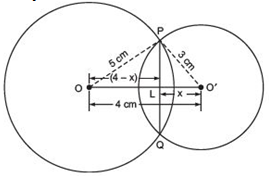
∵ In two intersecting circles, the line joining their centres is perpendicular bisector of the common chord.
∴ ∠OLP = ∠OLP = 90º
PL = PQ
Now in right ΔOLP,
PL2 + OL2 = OP2
⇒ PL2 + (4 - x)2 = 52
⇒ PL2 = 52 - (4 - x)2
⇒ PL2 = 25 - 16 - x2 + 8x
⇒ PL2 = 9 - x2 + 8x ...(1)
Again, in ΔO'LP,
PL2 = 32 - x2 = 9 - x2 ...(2)
From (1) and (2),
we have,
9 - x2 + 8x = 9 - x2
⇒ 8x = 0
⇒ x= 0
⇒ L and O' coincide.
∴ PQ is a diameter of the smaller circle.
⇒ PL = 3 cm
But, PL = LQ
∴ LQ = 3 cm
∴ PQ = PL + LQ
= 3 cm + 3 cm = 6 cm
Thus, the required length of the common chord = 6 cm.
2
Answer
We have a circle with centre O. Equal chords AB and CD intersect at E.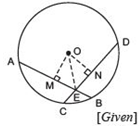
To prove that, AE = DE and CE = BE,
draw OM ⊥ AB and ON ⊥ CD.
Since AB = CD [Given]
∴ OM = ON [Equal chords are equidistant from the centre]
Now, in right ΔOME and right ΔONE,
OM = ON [Proved]
OE = OE [Common]
∴ ΔOME ≌ ΔONE [RHS criterion]
⇒ ME = NE [c.p.c.t.]
⇒ (1/2) AE = (1/2) DE [Perpendiculars from the centre bisect the chord.]
⇒ AE = DE ...(1)
Since, AB = CD (Given)
∴ AB - AE = CD - DE
⇒ CE = BE ...(2)
From (1) and (2),
We have, AE = DE and CE = BE
3
Answer
We have a circle with centre O and equal chords AB and CD are intersecting at E. OE is joined.To prove that ∠1 = ∠2, let us draw OM ⊥ AB and ON ⊥ CD.
In right ΔOME and right ΔONE,
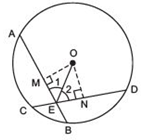
OM = ON [Equal chords are equidistant from the centre.]
OE = OE [Common]
∴ ΔOME ≌ΔONE [RHS criterion]
⇒ Their corresponding parts are equal.
∴ ∠OEM = ∠OEN
or ∠OEA = ∠OED
4

Answer
We have two circles with the common centre O.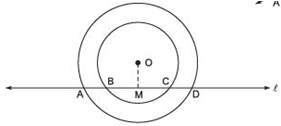
A line ‘l’ intersects the outer circle at A and D and the inner circle at B and C. To prove that AB = CD, let us draw OM ⊥ ℓ.
For the outer circle,
∵ OM ⊥ ℓ [Construction]
∴ AM = M D [∵ Perpendicular from the centre bisects the chord] ...(1)
For the inner circle,
∵ OM ⊥ ℓ [Construction]
∴ BM = MC [Perpendicular from the centre to the chord bisects the chord] ...(2)
Subtracting (2) from (1), we have,
AM - BM = MD - MC
⇒ AB = CD
5
Answer
Let the three girls Reshma, Salma and Mandip are positioned at R, S and M, respectively on the circle of radius 5 m.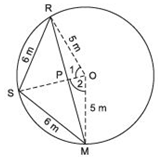
∵ RS = SM = 6 m [Given]
∵ Equal chords of a circle subtend equal angles at the centre.
∴ ∠1 = ∠2
In ΔPOR and ΔPOM,
OP = OP [Common]
OR = OM [Radii of the same circle]
∠1= ∠2 [Proved]
∴ ΔPOR ≌ ΔPOM [SAS criterion]
⇒ Their corresponding parts are equal.
∴ PR = PM and ∠OPR = ∠OPM
∵ ∠OPR + ∠OPM = 180º [Linear pairs]
∴ ∠OPR = ∠OPM = 90º
⇒ OP ⊥ RM
Now, in ΔRSP and ΔMSP,
RS = MS (6 m each)
SP = SP (Common)
∠RSP = ∠MSP
∴ ΔRSP ≌ ΔMSP [SAS criterion]
⇒ RP = MP and ∠RPS = ∠MPS [c.p.c.t]
But, ∠RPS + ∠MPS = 180°
⇒ ∠RPS = ∠MPS = 90º (Each)
∴ SP passes through O.
Let OP = x m
∴ SP = (5 - x) m
Now, in right ΔOPR,
x2 + RP2 = 52 …(1)
In right ΔSPR,
(5 - x)2 + RP2 = 62 …(2)
From (1),
RP2 = 52 - x2
From (2),
RP2 = 62 - (5 - x)2
∴ 52 - x2 = 62 - (5 - x)2
⇒ 25 - x2 = 36 - [25 - 10x + x2]
⇒ 25 - x2 - 36 + 25 - 10x + x2 = 0
⇒ -10x + 14 = 0
⇒ 10x = 14
⇒ x= (14/10) = 1.4
Now,
RP2 = 52 - x2
⇒ RP2 = 25 - (1.4)2
⇒ RP2 = 25 - 1.96 = 23.04 m
∴ RP =√(23.04) = 4.8 m
∴ RM = 2 RP = 2 x 4.8 m = 9.6 m
Thus, distance between Reshma and Mandip is 9.6 m.
6
Answer
In the figure, let Ankur, Syed and David are sitting at A, S and D respectively such that AS = SD = AD
i.e. ΔASD is an equilateral triangle.
Let the length of each side of the equilateral triangle is 2x metres.
Let us draw AM⊥SD.
Since ΔASD is an equilateral,
∴ AM passes through O.
⇒ SM = (1/2)SD = (1/2)(2x)
⇒ SM = x
Now, in right ΔASM,
AM2 + SM2 = AS2
⇒ AM2 = AS2 - SM2
⇒ AM2 = (2x)2 -x2
⇒ AM2 = 4x2 - x2
⇒ AM2 = 3x2
⇒ AM = 3x
Now,
OM = AM - OA = ( 3x - 20) m
Again, in right ΔOBM, we have
OS2 = SM2 + OM2
⇒ 202 = x2 + (3x - 20)2
⇒ 400 = x2 + 3x2 - 403 x + 400
⇒ 4x2 - 403 x= 0
⇒ 4x (x - 103) = 0
⇒ x = 0 or x = 103
But x = 0 is not required.
∴ x= 103 m
Now, SD = 2×m = 2 × 103 m
Thus, the length of the string of each phone = 2 × 103 m.
1
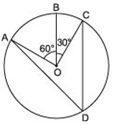
Answer
We have a circle with centre O, such that
∠ AOB = 60º and ∠BOC = 30º
∵ ∠AOB + ∠BOC = ∠AOC
∴ ∠AOC = 60º + 30º = 90º
Now, the arc ABC subtends ∠AOC = 90º at the centre and ∠ADC at a point D on the circle other than the arc ABC.

2
Answer
We have a circle having a chord AB equal to radius of the circle.∴ AO = BO = AB
⇒ ΔAOB is an equilateral triangle.
Since, each angle of an equilateral = 60º.
⇒ ∠AOB = 60º
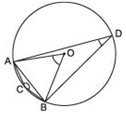
Since the arc ACB makes reflex,
∠AOB = 360º - 60º = 300º at the centre of the circle and ∠ABC at a point on the minor arc of the circle.

Thus,
the angle subtended by the chord on the minor arc = 150º and
on the major arc = 30º.
3
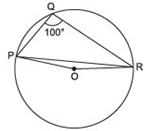
Answer
∵ The angle subtended by an arc of a circle at its centre is twice the angle subtended by the same arc at a point on the circumference.
∴ reflex ∠POR = 2∠PQR
But, ∠PQR = 100º
∴ reflex ∠POR = 2 × 100º = 200º
Since,
∠POR + reflex ∠POR = 360º
∴ ∠POR + 200º = 360º
⇒ ∠POR = 360º - 200º
⇒ ∠POR = 160º
Since, OP = OR [Radii of the same circle]
∴ In ΔPOR,
∠OPR = ∠ORP [Angles opposite to equal sides of a triangle are equal]
Also,
∠OPR + ∠ORP + ∠POR = 180º [Sum of the angles of a triangle = 180°]
⇒ ∠OPR + ∠OPR + 160º = 180º [∵ ∠OPR = ∠ORP]
⇒ 2∠OPR = 180º ∠ 160º = 20º
⇒ ∠OPR = (20º/2)= 10º
4

Answer
We have, in ΔABC,∠ABC = 69º and ∠ACB = 31º

But ∠ABC + ∠ACB + ∠BAC = 180º
∴ 69º + 31º + ∠BAC = 180º
⇒ ∠BAC = 180º - 69º - 31º = 80º
Since, angles in the same segment are equal.
∴ ∠BDC = ∠BAC
⇒ ∠BDC = 80º
5
Find ∠BAC.
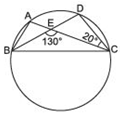
Answer
In ΔCDE,Exterior ∠BEC = {Sum of interior opposite angles}
[∵ BD is a straight line.]

130º = ∠EDC + ∠ECD
⇒ 130º = ∠EDC + 20º
⇒ ∠EDC = 130º - 20º = 110º
⇒ ∠BDC = 110º
Since, angles in the same segment are equal.
∴ ∠BAC = ∠BDC
⇒ ∠BAC = 110º
6
Answer
∵ Angles in the same segment of a circle are equal.∴ ∠BAC = ∠BDC
⇒ 30º = ∠BDC Also ∠DBC = 70º [Given]

∴ In ΔBCD, we have
∠BCD + ∠DBC + ∠CDB = 180º
[∵ Sum of angles of a triangle is 180º]
⇒ ∠BCD + 70º + 30º = 180º
⇒ ∠BCD = 180º - 70º - 30º = 80º
Now, in ΔABC,
∵ AB = BC [Given]
∴ ∠BCA = ∠BAC [Angles opposite to equal sides of a triangle are equal]
⇒ ∠BCA = 30º [∵ ∠BAC = 30º]
Now,
∠BCA + ∠ECD = ∠BCD
⇒ 30º + ∠ECD = 80º
⇒ ∠ECD = 80º - 30º = 50º
7
Answer
∵ AC and BD are diameters.∴ AC = BD [∵ All diameters of a circle are equal] …(1)
Since a diameter divides a circle into equal parts.
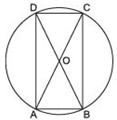
∴ ∠BAD = 90º [∵ Angle formed in a semicircle is 90º]
Similarly,
∠ABC = 90º, ∠BCD = 90º and ∠CDA = 90º
Now, in right ΔABC and right ΔBAD,
AC = BD [From (1)]
AB = AB [Common]
∴ ΔABC ≌ ΔBAD [RHS criterion]
⇒ BC = AD [c.p.c.t.]
Similarly, AB = CD
Thus, the cyclic quadrilateral ABCD is such that its opposite sides are equal and each of its angle is right angle.
∴ ABCD is a rectangle.
8
Answer
We have a trapezium ABCD such that AB || CD and AD = BC.Let us draw BE || AD such that ABED is a parallelogram.
∵ The opposite angles of a parallelogram are equal.
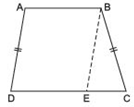
∴ ∠BAD = ∠BED …(1)
and AD = BE [Opposite sides of a parallelogram] …(2)
But AD = BC [Given] …(3)
∴ From (2) and (3), we have,
BE = BC
⇒ ∠BEC = ∠BCE [Angles opposite to equal sides of a triangle D are equal] …(4)
Now,
∠BED + ∠BEC = 180º [Linear pairs]
⇒ ∠BAD + ∠BCE = 180º [Using (1) and (4)]
i.e. A pair of opposite angles of quadrilateral ABCD is 180º.
∴ ABCD is cyclic.
⇒ The trapezium ABCD is a cyclic.
9

Answer
Since angles in the same segment of a circle are equal.
∴ ∠ACP = ∠ABP …(1)
Similarly,
∠QCD = ∠QBD …(2)
Since, ∠ABP = ∠QBD [Vertically opposite angles are equal]
∴ From (1) and (2), we have ∠ACP = ∠QCD
10
Answer
We have a DABC, and two circles described with diameters as AB and AC respectively. They intersect in a point D.Let us join A and D.
∵ AB is a diameter.
∴ ∠ADB is an angle formed in a semicircle.
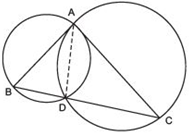
⇒ ∠ADB = 90º …(1)
Similarly, ∠ADC = 90º …(2)
Adding (1) and (2), we have
∠ADB + ∠ADC = 90º + 90º = 180º
i.e. B, D and C are collinear points.
⇒ BC is a straight line.
Thus, D lies on BC.
11
Answer
We have right ΔABC and right ΔADC such that they are having AC as their common hypotenuse.∵ AC is a hypotenuse.
∵ ∠ADC = 90º = ∠ABC
∴ Both the triangles are in the same semicircle.
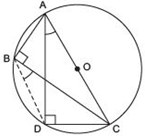
⇒ A, B, C and D are concyclic.
Let us join B and D.
∵ DC is a chord.
∴ ∠CAD and ∠CBD are formed in the same segment.
⇒ ∠CAD = ∠CBD.
12
Answer
We have a cyclic parallelogram ABCD.Since, ABCD is a cyclic quadrilateral.
∴ Sum of its opposite angles = 180º
⇒ ∠A + ∠C = 180º …(1)
But ∠A = ∠C …(2)

[∵ Opposite angles of parallelogram are equal]
From (1) and (2), we have
∠A= ∠C = 90º
Similarly, ∠B= ∠D = 90º
⇒ Each angle of the parallelogram ABCD is of 90º.
Thus, ABCD is a rectangle.
1
Answer
We have two circles with centres O and O' respectively such that they intersect each other at P and Q.To prove that ∠OPO' = ∠OQO',
let us join OP, O'P, OQ, O'Q and OO'.
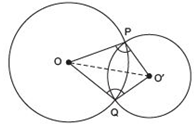
In ΔOPO' and ΔOQO', we have
OP = OQ [Radii of the same circle]
O'P= O'Q [Radii of the same circle]
OO' = OO' [Common]
∴ Using the SSS criterion, ΔOPO'≌ ΔOQO'
∴ Their corresponding parts are equal.
Thus, ∠OPO' = ∠OQO'
2
Answer
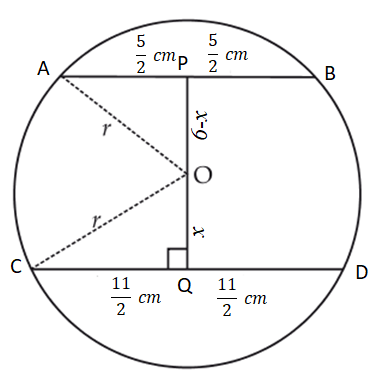
Let ‘r’ be the radius of the circle.
Let us draw OP ⊥ AB and OQ ⊥ CD.
We join OA and OC.
Let OQ = x cm
∴ OP = (6 - x) cm [∵ PQ = 6 cm]
∵ The perpendicular from the centre of a circle to chord bisects the chord

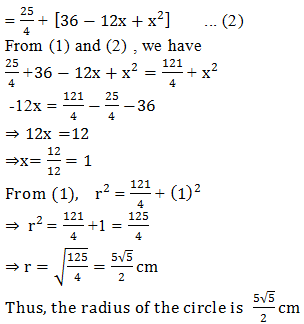
3
REMEMBER : The longer chord in a circle is nearer to the centre than the smaller chord.
Answer
We have a circle with centre O. Parallel chords AB and CD are such that the smaller chord is 4 cm away from the centre.Let us draw OP ⊥ AB and join OA and OC.
∴ OP ⊥ AB
∴ P is the mid-point of AB.
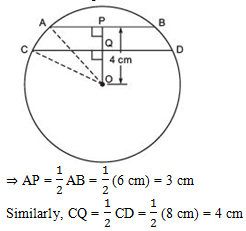
Now in right ΔOPA, we have
OA2 = OP2 + AP2
⇒ r2 = 42 + 32
⇒ r2 = 16 + 9 = 25
⇒ r=√25 = 5 cm
Note: r2 = 25
⇒ r = ± 5
But we reject r = -5, because distance cannot be negative.
Again, in right ΔCQO, we have
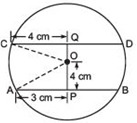
OC2 = OQ2 + CQ2
⇒ r2 = OQ2 + 42
⇒ OQ2 = r2 − 42
⇒ OQ2 = 52 − 42 = 25 − 16 = 9 [∵ r = 5 cm]
⇒ OQ = √9 = 3 cm
The distance of the other chord (CD) from the centre is 3 cm.
Note: In case we take the two parallel chords on either side of the centre, then
In ΔPOA,
OA2 =OP2 + PA2
⇒ r2 =42 + 32 = 52
⇒ r = 5 cm
In ΔQOC,
OC2 =CQ2 + OQ2
⇒ r2 =42 + OQ2
⇒ OQ2 = 52 - 42 = 9
⇒ OQ = 3 cm
4
Answer
We have an ∠ABC such that the arms BA and BC on production, make two equal chords AD and CE. Let us join AC, DE and AE
∵ An exterior angle of a triangle is equal to the sum of interior opposite angles.
∴ In ΔBAE, we have Exterior
∠DAE = ∠ABC + ∠AEC …(1)
∵ The chord DE, subtends ∠DOE at the centre and ∠DAE in the remaining part of the circle.
∴ ∠DAE = (1/2)∠DOE …(2)
Similarly,
∠AEC =(1/2)∠AOC …(3)
From (1), (2) and (3), we have
(1/2)∠DOE = ∠ABC + (1/2)∠AOC
⇒ ∠ABC = (1/2)∠DOE - (1/2)∠AOC
⇒ ∠ABC = (1/2) [∠DOE - ∠AOC]
⇒ ∠ABC = (1/2)[(Angle subtended by the chord DE at the centre) - (Angle subtended by the chord AC at the centre)]
⇒ ∠ABC =(1/2) [Difference of the angles subtended by the chords DE and AC]
5
Answer
We have a rhombus ABCD such that its diagonals AC and BD intersect at O.Taking AB as diameter, a circle is drawn. Let us draw PQ || AD and RS || AB, both passing through O. P, Q, R and S are the mid-points of DC, AB, AD and BC respectively. ∵ All the sides of a rhombus are equal.

∴ AB = DC
⇒ (1/2) AB =(1/2) DC
⇒ AQ = DP
⇒ BQ = DP
⇒ AQ = BQ [∵ Q is the mid-point of AB] ...(1)
Similarly,
RA = SB
⇒ RA = QO [∵ PQ is drawn parallel to AD] …(2)
From (1) and (2), we have
QA = QB = QO
i.e. A circle drawn with Q as centre, will pass through A, B and O.
Thus, the circle passes through the point of intersection (O) of the diagonals of the rhombus ABCD.
6
Answer
We have a parallelogram ABCD. A circle passing through A, B and C is drawn such that it intersects CD at E.∵ ABCE is a cyclic quadrilateral.
∴ ∠AEC + ∠B = 180º …(1)
[∵ Opposite angles of a cyclic quadrilateral are supplementary]
But ABCD is a parallelogram. [Given]
∴ ∠D= ∠B …(2)
[∵ Opposite angles of a parallelogram are equal]

From (1) and (2), we have
∠AEC + ∠D = 180º …(3)
But, ∠AEC + ∠AED = 180º …(4)
From (3) and (4), we have ∠D= ∠AED
i.e. The base angles of ΔADE are equal.
∴ Opposite sides must be equal.
⇒ AD = AE
7
(i) AC and BD are diameters,
(ii) ABCD is a rectangle.
Answer
We have a circle with centre at O. Two chords AC and BD are such that they bisect each other. Let their point of intersection be O.
Let us join AB, BC, CD and DA.
(i) To prove that AC and BD are the diameters of the circle.
In ΔAOB and ΔCOD, we have
AO = OC [∵ O is the mid-point of AC]
BO = DO [∵ O is the mid-point of BD]
∠AOB = ∠COD [Vertically opposite angles]
∴ Using the SAS criterion of congruence,
ΔAOB ≌ ΔCOD
⇒ AB = CD
⇒ arc AB = arc CD ...(1)
Similarly,
arc AD = arc BC ...(2)
Adding (1) and (2),
arc AB + arc AD = arc CD + arc BC![]()
⇒ BD divides the circle into two equal parts.
∴ BD is a diameter.
Similarly, AC is a diameter.
(ii) To prove that ABCD is a rectangle.
We have already proved that, ΔAOB ≌ ΔCOD
⇒ ∠OAB = ∠OCD
⇒ ∠BAC = ∠ABD (c.p.c.t)
⇒ AB || CD
Similarly,
AD || BC
∴ ABCD is a parallelogram.
Since, opposite angles of a parallelogram are equal.
∴ ∠DAB = ∠DCB
But ∠DAB + ∠DCB = 180º [∵ Sum of the opposite angles of a cyclic quadrilateral is 180º]
⇒ ∠DAB = 90º = ∠DCB
Thus, ABCD is a rectangle.
8
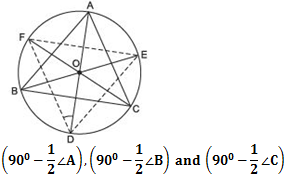
Answer
We have a triangle ABC inscribed in a circle, such that bisectors of ∠A, ∠B and ∠C intersect the circumcircle at D, E and F respectively.Let us join DE, EF and FD.
∵ Angles in the same segment are equal.
∴ ∠FDA = ∠FCA …(1)
∠EDA = ∠EBA …(2)
Adding (1) and (2), we have
∠FDA + ∠EDA = ∠FCA + ∠EBA
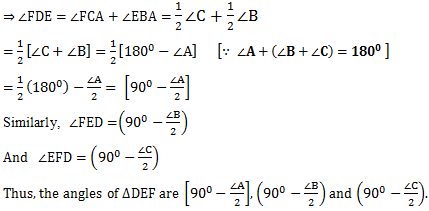
9
Answer
We have two congruent circles such that they intersect each other at A and B. A line passing through A, meets the circle at P and Q. Let us draw the common chord AB.
∵ Angles subtended by equal chords in the congruent circles are equal.
∴ ∠APB = ∠AQB
Now, in ΔPBQ, we have
∠1= ∠2 [Proved]
∴ Their opposite sides must be equal.
⇒ PB = BQ
10
Answer
We have a ΔABC inscribed in a circle. The internal bisector of ∠A and the bisector of BC intersect at E.
Let us join BE and CE.
∵ ∠BAE = ∠CAE [∵ AE is the bisector of ∠ BAC]
∴ arc BE = arc EC
⇒ chord BE = chord EC
In ΔBDE and ΔCDE, we have
BE = CE
BD = CD [Given]
DE = DE [Common]
∴ By SSS criterion of congruence,
ΔBDE ≌ ΔCDE
⇒ Their corresponding parts are equal.
∴ ∠BDE = ∠CDE
But ∠BDE + ∠CDE = 180º [Linear pairs]
⇒ ∠BDE = ∠CDE = 90º i.DE ⊥ BC
Thus, DE is the perpendicular bisector of BC.